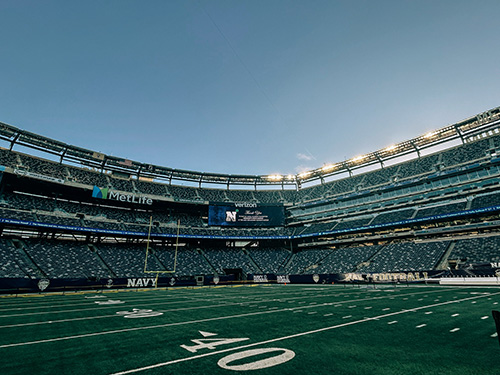NAVY AND NOTRE DAME: BEYOND THE GRIDIRON
 On 25 October, on the eve of the annual Navy-Notre Dame game, members of the U.S. Naval Academy Foundation’s President’s Circle giving society gathered at MetLife Stadium in New Jersey for an exclusive tour, courtesy of Bill Squires ’75.
On 25 October, on the eve of the annual Navy-Notre Dame game, members of the U.S. Naval Academy Foundation’s President’s Circle giving society gathered at MetLife Stadium in New Jersey for an exclusive tour, courtesy of Bill Squires ’75.
During the event—the first of its kind in a slate of signature events thanking our most generous donors at the Luce and Lejune levels of giving—participants toured locker rooms and enjoyed an on-field experience. The event was new, but the football game that would follow the next day was part of a storied tradition going back nearly a century.
Navy and Notre Dame first squared off on the gridiron in 1927, and with the exception of the 2020 game that was canceled due to the COVID-19 pandemic, they have met every year since. This gives the matchup the distinction of being the longest continuous intersectional rivalry in college football.
It’s no secret that the Fighting Irish have historically dominated the series, but what isn’t as well-known is the rich history rooted in this rivalry, and the reason why it continues to this day.
The answer lies at the onset of World War II.
More than 80% of Notre Dame’s student population—all-male at the time—had joined the military within a year of the war starting. Just 700 civilian students remained, who were either too young to join the service or disqualified due to medical reasons.
This placed tremendous strain on the university’s finances, putting it at risk of shuttering its doors. In 1941, then-president of Notre Dame, Rev. J. Hugh O’Donnell, C.S.C., had an idea that would not only save the school but build upon Notre Dame’s long-standing commitment to military service. He wrote a letter to Admiral Chester Nimitz, offering the university’s campus and facilities to train the naval officers needed in increasingly large numbers to fight the war.
Admiral Nimitz agreed, and by the time the war was over, more than 12,000 midshipmen had studied, trained, and were commissioned as officers in the U.S. Navy through the Notre Dame program. During this period, Notre Dame earned the moniker “Annapolis West” because of how many officers its program produced.
The financial support from this arrangement proved to be critical for Notre Dame’s survival. As Rev. Theodore M. Hesburgh, C.S.C., Notre Dame’s longest-serving president, once said, “We were out of business during World War II. The Navy came in and kept us afloat until the war was over.”
In the decades since, Notre Dame football has committed to keeping a spot for the Naval Academy on its schedule every season as a show of gratitude for the Navy’s assistance when it was needed most. The first time this historic series was officially renewed was 1947, and it was most recently renewed through the 2032 season—but these renewals are a mere formality. The deep shared history and mutual respect between the two programs will carry this partnership indefinitely into the future.
The ties that bind the Naval Academy and Notre Dame together go deeper than a shared history and annual football tradition, however. There’s a special sense of mission, purpose, honor, and commitment that permeates both schools. And Notre Dame is home to the largest NROTC training command in the country, second only to the Naval Academy in the number of Navy and Marine Corps officers it commissions.
This alignment has fostered a desire from leadership at both the Academy and Notre Dame to extend and enhance their relationship well beyond the gridiron. This summer, thanks to the generous support of Mr. John Crowley ‘90, USNA Foundation board member, and his wife Aileen, a select group of midshipmen and NROTC students from Notre Dame traveled to London and France to study history, moral leadership, and ethical decision-making in World War II.
During this trip, hosted through the Academy’s Center for Experiential Leadership Development (ELD), future naval officers from both schools visited historic sites such as Churchill’s War Rooms, the Royal Naval College, Bletchley Park, the battlefields of Normandy, and the American Cemetery while gaining a deeper understanding of the lasting impact of ethical leadership during times of conflict.
With this trip serving as a foundation, we believe that the future of collaboration between the Naval Academy and Notre Dame can be just as rich as our shared history. We look forward to continuing what has always been a special relationship borne of mutual respect—both on and off the football field.